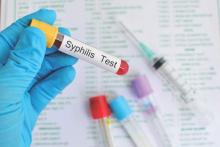Because syphilis infection rates have increased over the last decade, health care providers should screen patients for the disease more frequently to detect and treat it earlier and more effectively, particular in high-risk subgroups.
The United States Preventive Services Task Force made this recommendation in a JAMA article published online, the first update to the syphilis screening recommendation since 2004 (JAMA. 2016;315[21]:2321-2327. doi: 10.1001/jama.2016.5824).
“Individuals with previous syphilis infection, an infected sexual partner, current HIV infection, or more than 4 sex partners in the preceding year are at increased risk of acquiring syphilis,” the report states. “Higher prevalence rates are associated with sociodemographic groups including men who have sex with men (MSM), young adult men, sex workers, adults in correctional facilities, and individuals who are black or live in metropolitan areas in the southern and western United States. Men who have sex with men accounted for 61% of all primary and secondary syphilis cases reported in 2014.”
A systematic review of trials and studies investigating syphilis screening effectiveness, testing accuracy, and screening risks in nonpregnant adults and adolescents – all of which were included in the Cochrane Central Register of Controlled Trials and Cochrane Database of Systematic Reviews through October 2015, along with the Ovid MEDLINE database from January 2004 through October 2015 – was undertaken to update the 2004 recommendations.
Studies with clinical application were emphasized more heavily, along with those that focused on target populations of asymptomatic, sexually active, adolescent and older men and women. In total, 2,000 English-language titles and abstracts were reviewed, from which 448 full-text studies underwent further review for inclusion. From these, only nine were ultimately selected for inclusion, four of which were observational studies, three of which were observational studies of test accuracy, and two of which were observational studies of testing sequences.
The first four studies – Bissessor et al. 2010, Cohen et al. 2005, Zou et al. 2013, and Bissessor et al. 2011 – were included to answer the investigation’s key question 1 (KQ1) – “What is the effectiveness of screening for syphilis in reducing complications of the disease and transmission or acquisition of other sexually transmitted infections in asymptomatic, nonpregnant, sexually active adults and adolescents? What is the effectiveness of specific screening intervals and screening among population subgroups?”
The remaining five studies – Wong et al. 2011, Tsang et al. 2007, Juárez-Figueroa et al. 2007, Mishra et al. 2011, and Binnicker et al. 2012 – were aimed at KQ3, asking “What is the accuracy of currently used screening tests and strategies (e.g., sequence of tests) for detecting syphilis infection?”
Regarding KQ1, all four studies found that MSM and HIV-infected men who were screened routinely every 3 months had a significantly higher rate of syphilis detection compared with those who were screened annually. The studies, all of which came from Europe and Australia, detected syphilis early in those who were screened every 3 months in 8.1% of HIV-infected MSM versus 3.1% of those who screened annually (P = .001), detected early-latent syphilis in 1.7% of routine screeners versus 0.4% of annual screeners (P = .008), and detected early syphilis in higher-risk MSM in 53% of regular screeners versus just 16% of annual screeners (P = .001). The cohort comprised 6,789 asymptomatic MSM.
In addition, newly acquired syphilis in HIV-positive MSM was found in 7.3 cases per 1,000 patient-years (95% CI, 5.2-9.9) for those who were regularly screened, versus 2.8 cases per 1,000 patient-years (95% CI, 1.8-4.0) for those who were screened annually.
Of the five studies investigating KQ3, three (Wong, Tsang, Juárez-Figueroa) were observational studies of treponemal and nontreponemal tests to detect syphilis. Results indicated that both tests had a sensitivity of 85.3%-98%, and specificity of 91%-100%. However, the remaining two studies (Mishra, Binnicker) used reverse screening algorithms to confirm positive test results from treponemal and nontreponemal, finding higher rates of false positives in the rapid plasma reagin than in the traditional enzyme analyses: 0.6% vs. 0.0% in one study (P = .03) and 0.26% vs. 0.13% in the other.
“Additional research on syphilis screening is needed to directly compare the effectiveness of different screening strategies for identifying individuals at increased risk of infection, co-testing for concurrent STIs, and different screening intervals among various patient populations,” wrote the USPSTF investigators, adding that research also is needed on evaluating the instruments used in risk assessment, as well as diagnostic accuracy.
Furthermore, while the data from these studies have shed light on syphilis testing and screening, several other important components of disease treatment and prevention – namely, “the effectiveness of screening in reducing syphilis complications and transmission, effectiveness of risk assessment methods, and harms related to screening” – were not adequately addressed.


